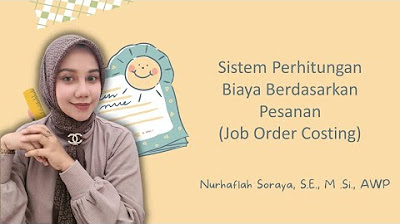Job Costing - Part I
Summary
TLDRThis video provides an in-depth look at job costing, focusing on its fundamental components, such as direct and indirect costs, and the distinction from process costing. It outlines a seven-step approach to effectively determine job costs, illustrated with practical examples. Key documentation for tracking costs is emphasized, along with a comparison between actual and normal costing methods. The session aims to equip viewers with the knowledge needed to accurately assess the costs associated with specific jobs, enhancing their understanding of financial management in manufacturing.
Takeaways
- 😀 Job costing is essential for determining the costs associated with specific orders or projects.
- 😀 Understanding cost objects is crucial for accurately assigning costs to jobs.
- 😀 Direct costs are directly traceable to a job, while indirect costs (overheads) need to be allocated.
- 😀 The distinction between job costing and process costing lies in the nature of the product: unique jobs versus mass production.
- 😀 The seven-step approach to job costing includes identifying the cost object and direct costs, selecting an allocation base, and calculating total job costs.
- 😀 An example illustrates the calculation of total job costs, including direct and indirect costs.
- 😀 Gross margin can be calculated by subtracting total job costs from revenue, allowing assessment of profitability.
- 😀 Key sources of information for job costing include job cost records, materials requisition records, and labor time records.
- 😀 Actual costing uses actual incurred costs, while normal costing applies budgeted indirect cost rates for overhead allocation.
- 😀 Understanding these concepts is vital for effective financial management in manufacturing and service industries.
Q & A
What is job costing?
-Job costing is a costing method that assigns costs to specific jobs or orders, typically used in industries where products are made to customer specifications.
What are the key building blocks of a costing system?
-The key building blocks include identifying a cost object, determining direct costs, and allocating indirect costs associated with that cost object.
How are direct and indirect costs treated in job costing?
-Direct costs are traced directly to the job, while indirect costs (overheads) are allocated to the job based on a predetermined cost allocation base.
What is the difference between job costing and process costing?
-Job costing is used for distinct, custom jobs, while process costing is used for large volumes of identical or similar products.
Can you outline the seven-step approach to job costing?
-The seven steps include: 1) Identify the cost object; 2) Determine direct costs; 3) Select a cost allocation base; 4) Identify indirect costs; 5) Compute the rate per unit; 6) Allocate indirect costs; 7) Calculate total job cost.
What is a cost allocation base?
-A cost allocation base is a measure used to allocate indirect costs to different jobs, such as machine hours or labor hours.
How is the gross margin calculated in job costing?
-Gross margin is calculated by subtracting the total job cost from the revenue generated from the job.
What are some source documents used in job costing?
-Key source documents include the job cost record, materials requisition record, and labor time record.
What is the difference between actual costing and normal costing?
-Actual costing uses actual costs for job costing, while normal costing uses budgeted indirect cost rates to allocate indirect costs.
Why is it important to distinguish between direct and indirect costs?
-Understanding the distinction is crucial for accurately allocating costs and determining the profitability of specific jobs.
Outlines

Этот раздел доступен только подписчикам платных тарифов. Пожалуйста, перейдите на платный тариф для доступа.
Перейти на платный тарифMindmap

Этот раздел доступен только подписчикам платных тарифов. Пожалуйста, перейдите на платный тариф для доступа.
Перейти на платный тарифKeywords

Этот раздел доступен только подписчикам платных тарифов. Пожалуйста, перейдите на платный тариф для доступа.
Перейти на платный тарифHighlights

Этот раздел доступен только подписчикам платных тарифов. Пожалуйста, перейдите на платный тариф для доступа.
Перейти на платный тарифTranscripts

Этот раздел доступен только подписчикам платных тарифов. Пожалуйста, перейдите на платный тариф для доступа.
Перейти на платный тариф5.0 / 5 (0 votes)






